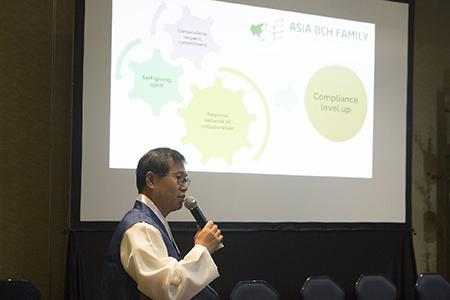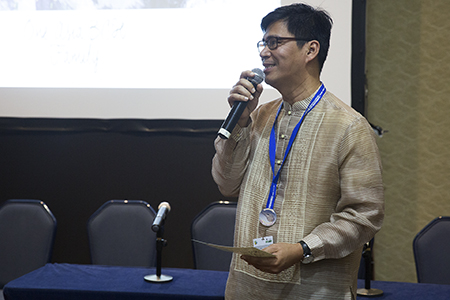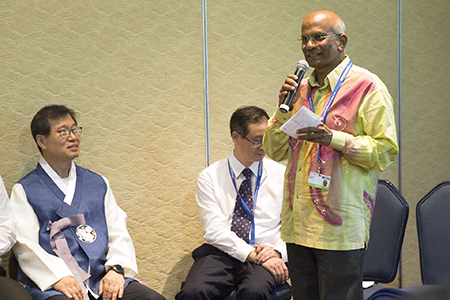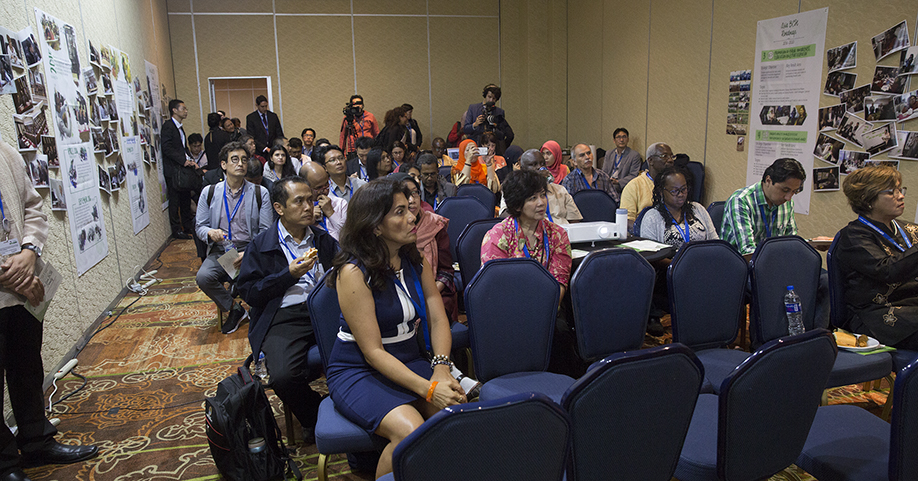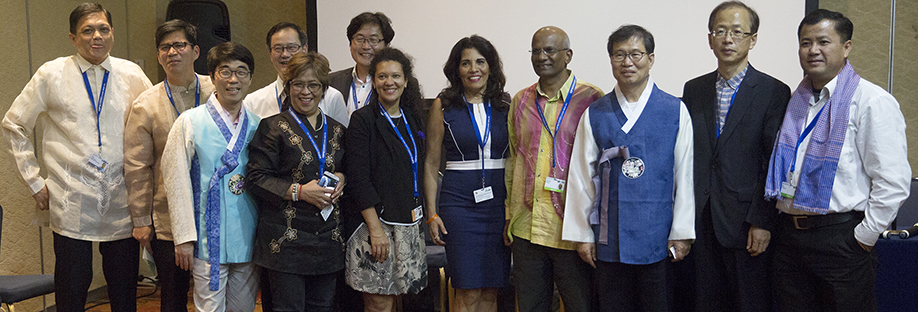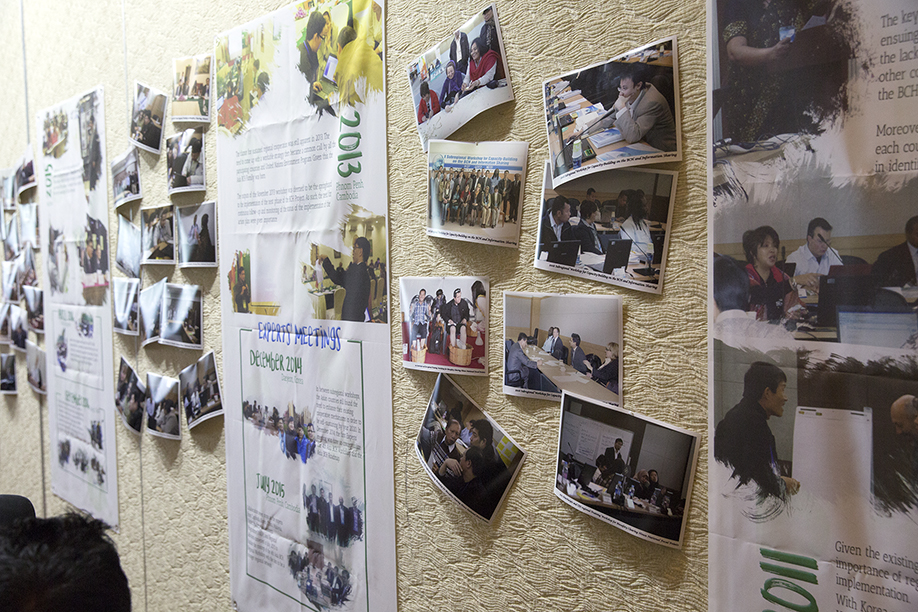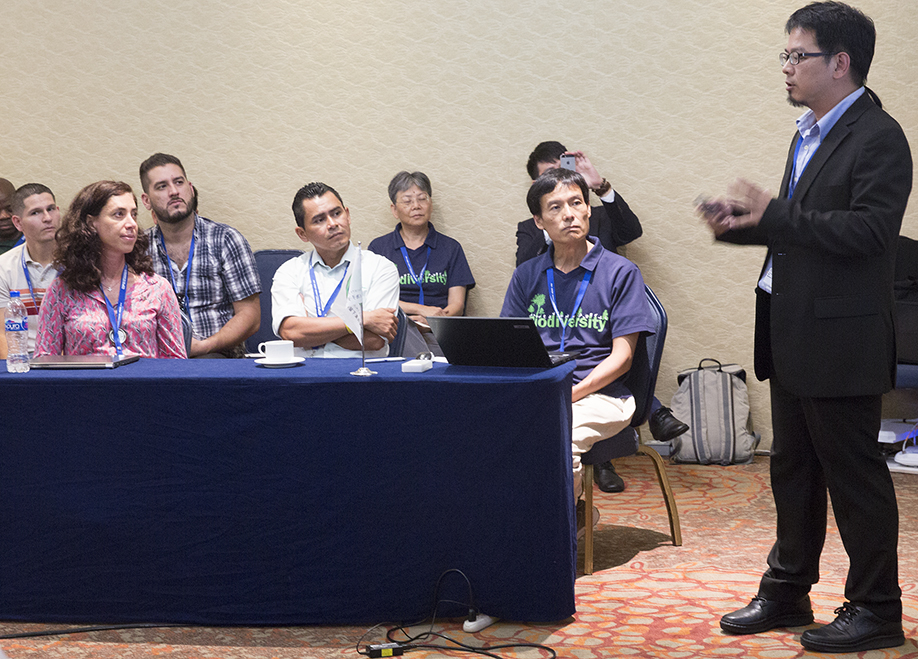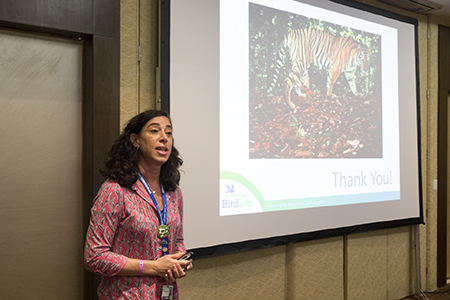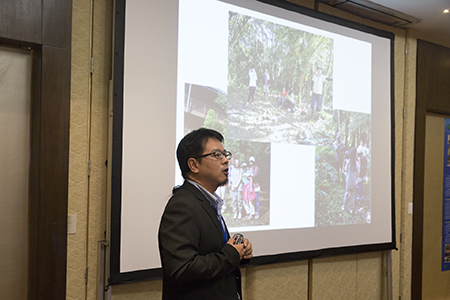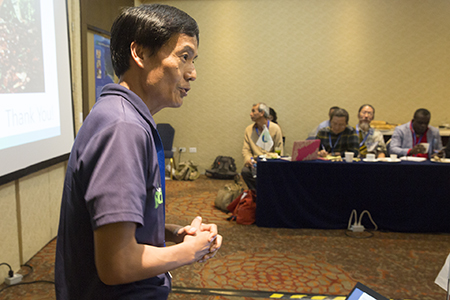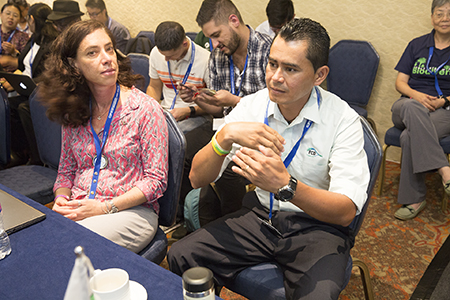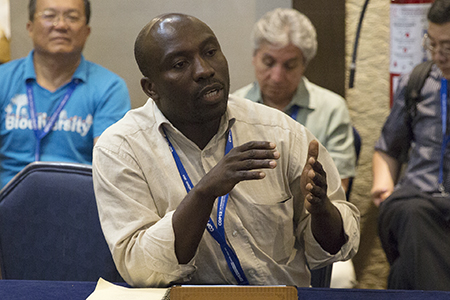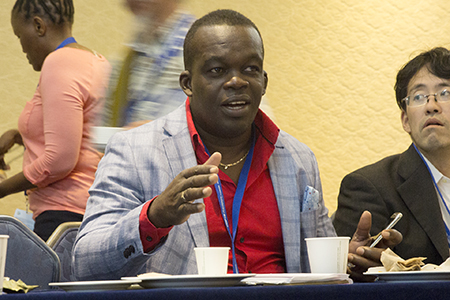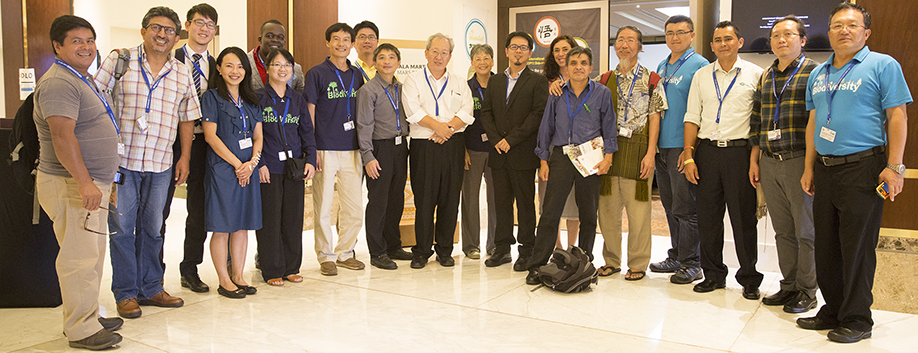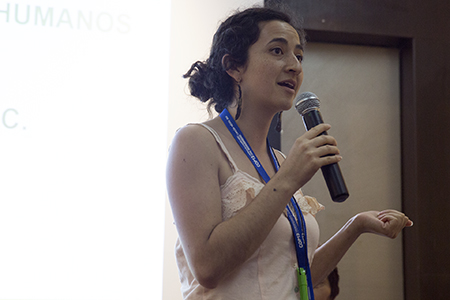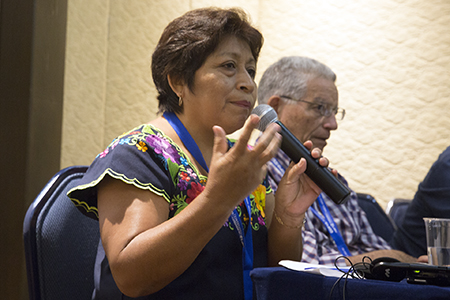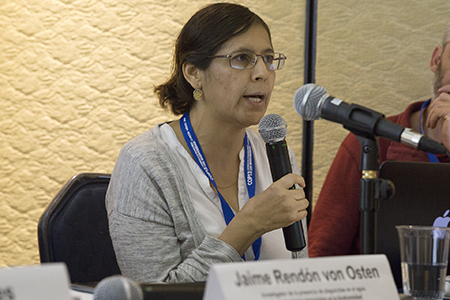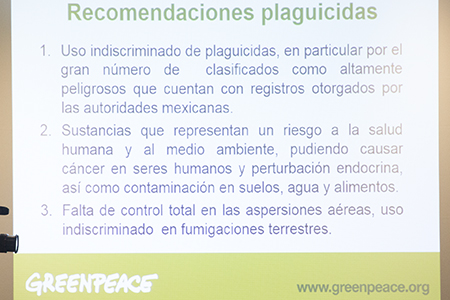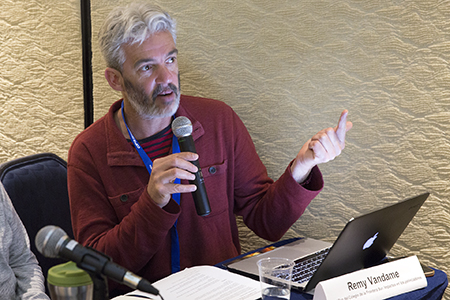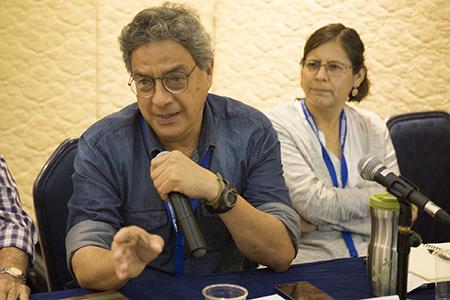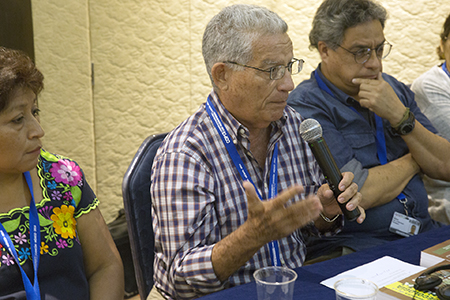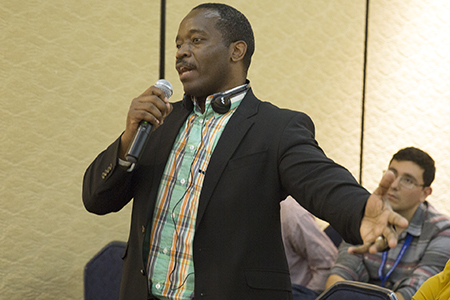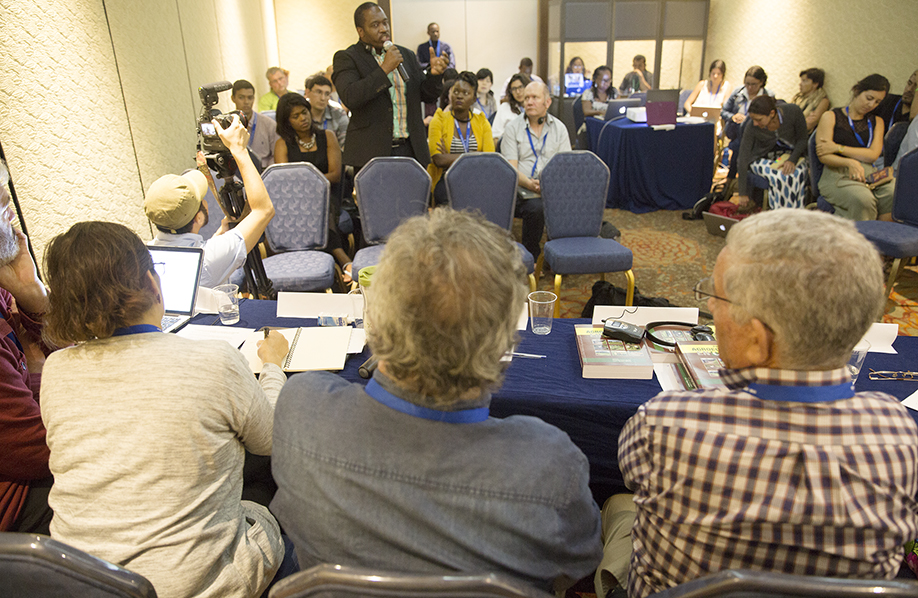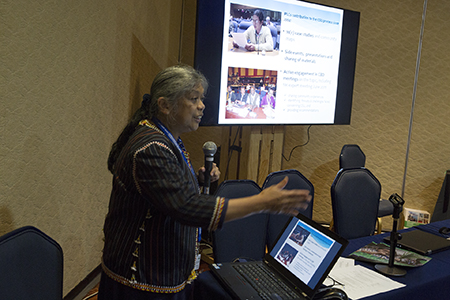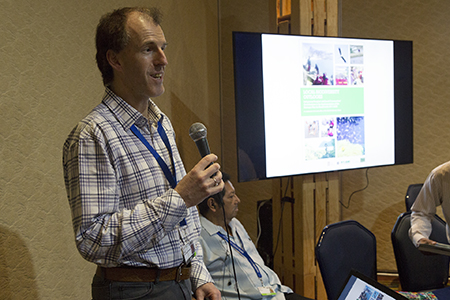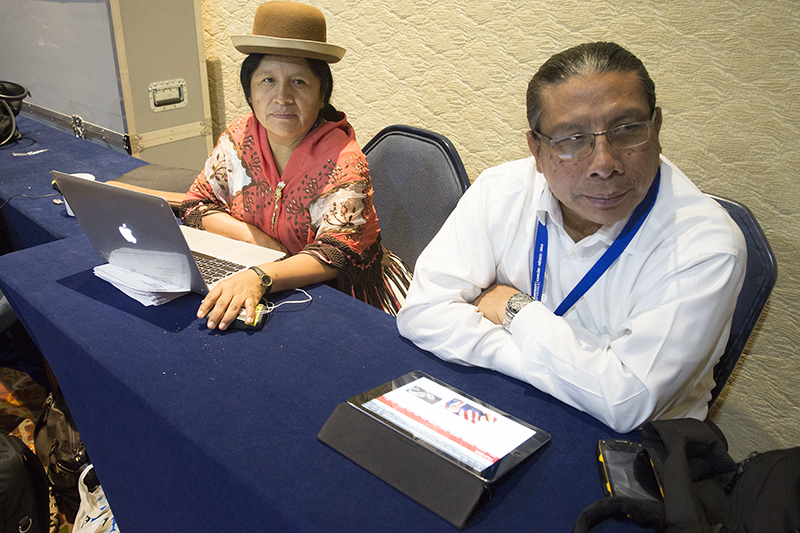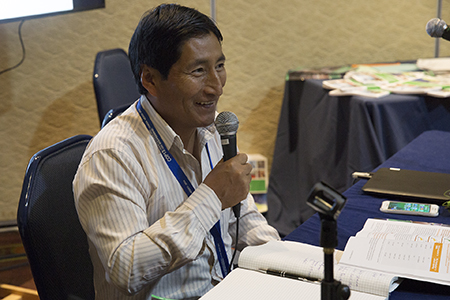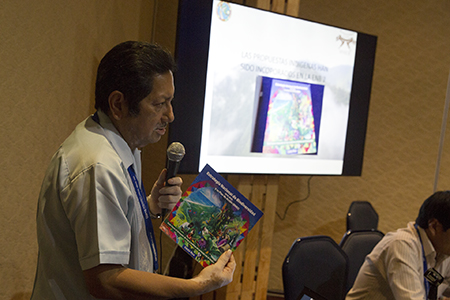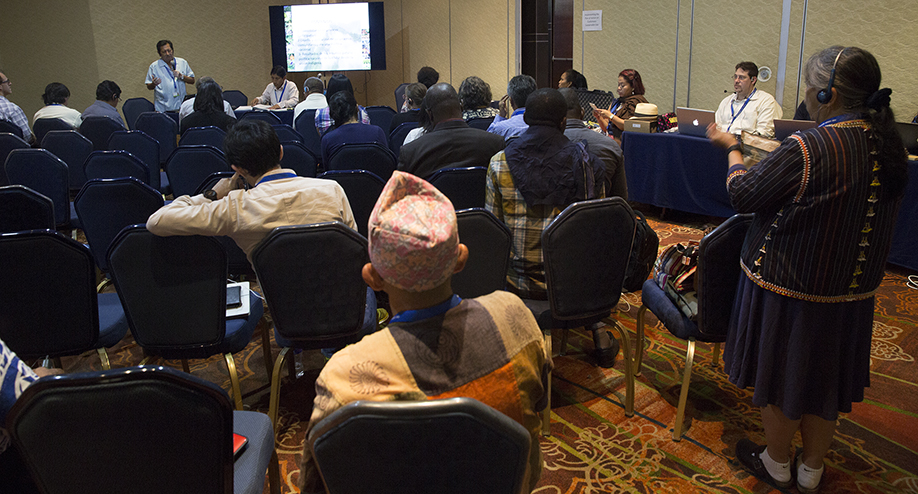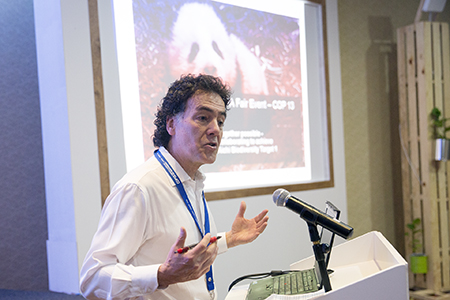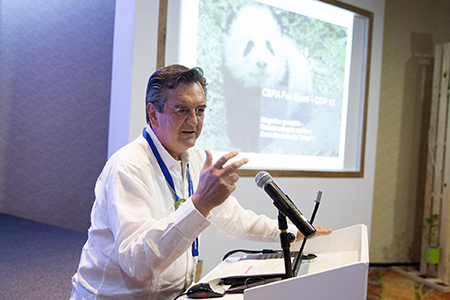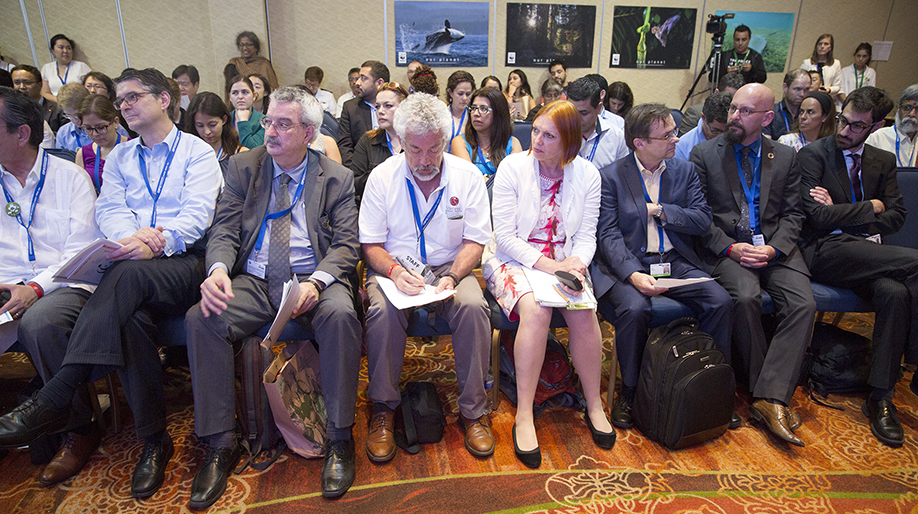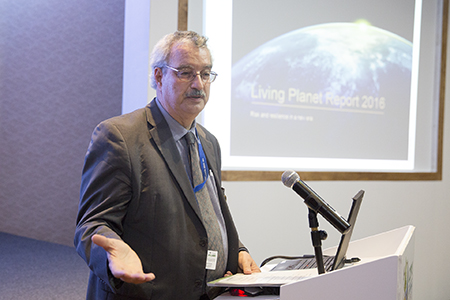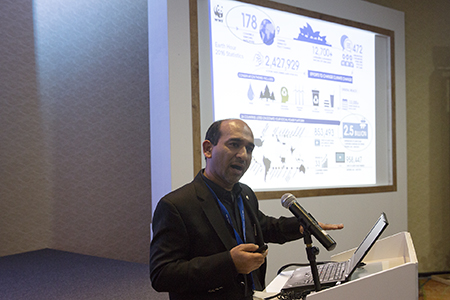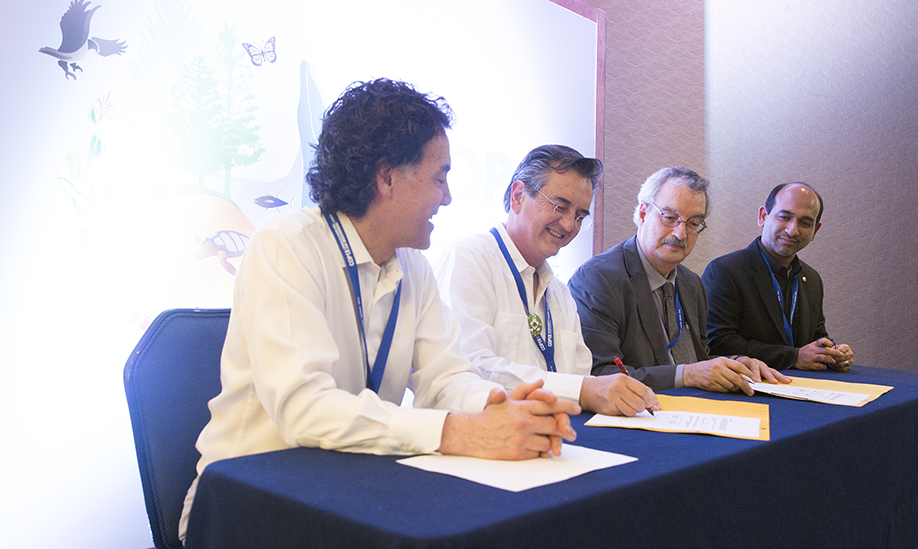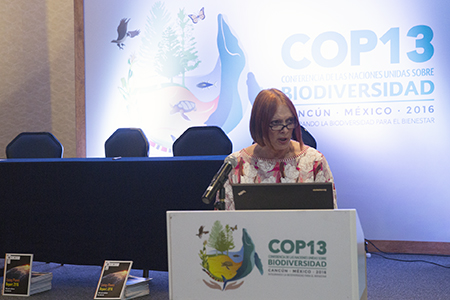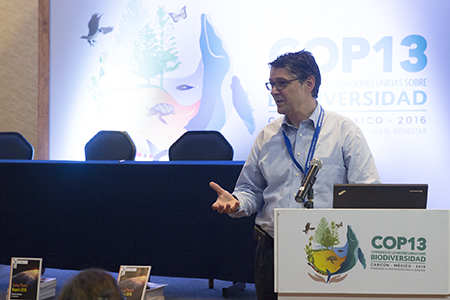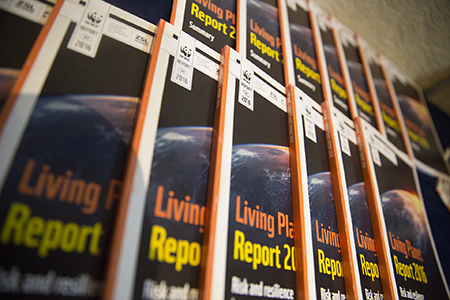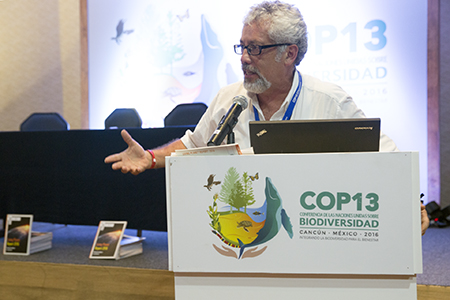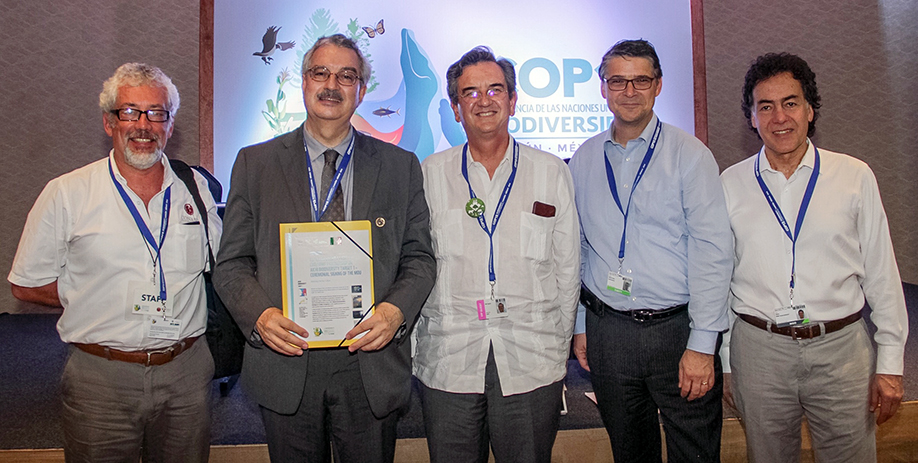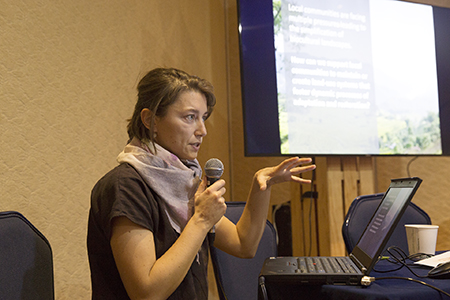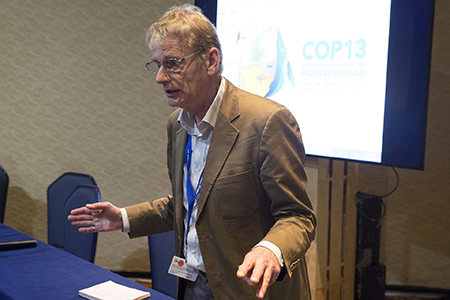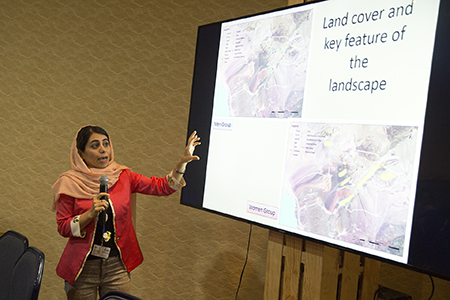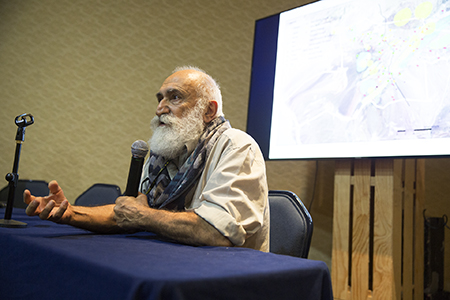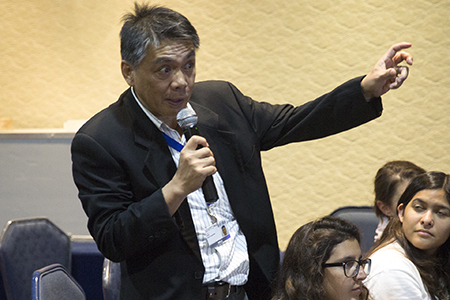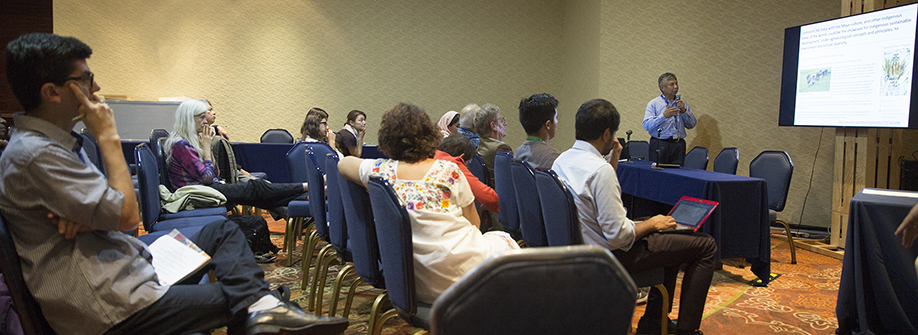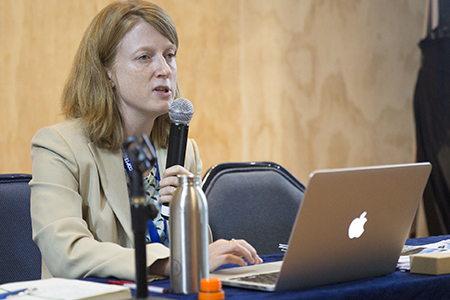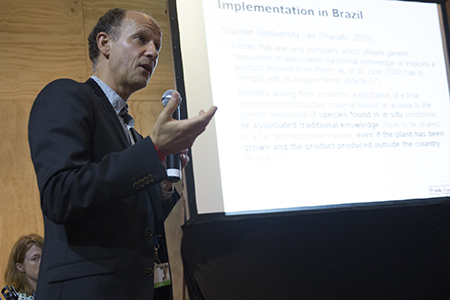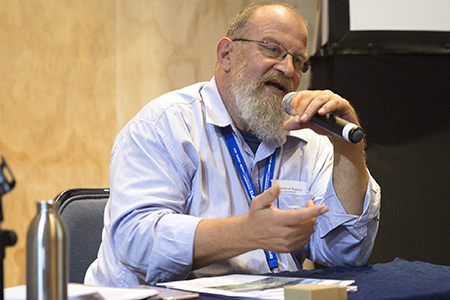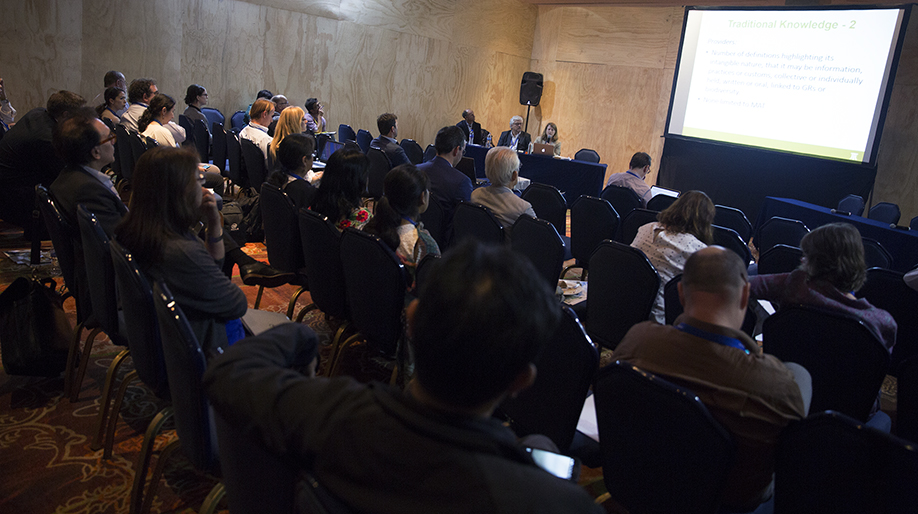Summary
The following events were covered by IISD Reporting Services on Wednesday, 14 December 2016:
- A Successful Biosafety Clearing House (BCH) Asia Family
- Rooted in the Ground: Community Participation and Biodiversity
- Mainstreaming Biodiversity in Agriculture - Pesticides and its Impacts on Bees as a Key Discussion
- Implementing the Plan of Action on Customary Sustainable Use (CSU)
- Convention of Biological Diversity (CBD) - World Wildlife Fund (WWF) Partnership on Aichi Biodiversity Target 1- Ceremonial Signing of the Memorandum of Understanding (MOU)
- Land Use Decisions and Agricultural Biodiversity
- Diverging Access and Benefit Sharing (ABS) Laws in North and South – What are the Consequences?
IISD Reporting Services, through its ENBOTS Meeting Coverage, is providing daily web coverage of selected side-events from the UN Biodiversity Conference.
Photos by IISD/ENB | Diego Noguera
For photo reprint permissions, please follow instructions at our Attribution Regulations for Meeting Photo Usage Page.
A Successful Biosafety Clearing House (BCH) Asia Family
Presented by the Division of Environmental Law and Conventions of the UN Environment Programme (UNEP-DELC)
This event, moderated by Ruel Maningas, Colegio de San Juan de Letran Calamba, the Philippines, was organized to recognize the Asian BCH collaboration that unites Asian countries in a common goal of full compliance with the Cartagena Protocol on Biosafety.
In opening remarks, Homin Jang, Korea Research Institute of Bioscience and Biotechnology (KRIBB), retraced the journey of the formation of the Asia BCH Family from 2008, highlighting milestones, leading to the development of the Asia BCH Roadmap at the fourth Asia BCH Regional Workshop in 2015 in Nanjing, China.
Letchumanan Ramatha, Ministry of Natural Resources and Environment, Malaysia, emphasized that the success of the Family depends on the ability of all members to support and uplift each other in order to complement each other’s strengths and weaknesses.
Changyong Wang, Nanjing Environmental Science Institute, China, said the country is committed to continued support for the BCH Road Map, and highlighted activities such as: training for genetically-modified organism (GMO) detection in collaboration with the Republic of Korea; capacity building in risk assessments and detection of gene flows across Asian countries; and the management of transboundary issues.
Julieta Fe L. Estacio, Philippines Department of Science and Technology (DOST), confirmed that her country would continue coordinating activities of the BCH Roadmap to build capacity towards effective participation to the BCH, promote public awareness, education and information, and enhance regional networking and cooperation.
Ileana Lopez, UN Environment, lauded the Asia BCH Family for their initiative, referring to their cooperation as the right basis for ensuring environmental self-sustainability regionally.
Homin Jang, KRIBB, said the spirit of camaraderie and collaboration in the Asia BCH Family is thanks to respect, commitment and the self-giving spirit of its members.
Ruel Maningas, Colegio de San Juan de Letran Calamba, Philippines, moderated this event.
Letchumanan Ramatha, Ministry of Natural Resources and Environment, Malaysia, called for further mobilization to “move together in order to meet compliance with the Cartagena Protocol, together.”
Ileana López, UN Environment, urged other regions to consider similar initiatives following the model of the Asia BCH Family.
Participants during the event
Group photo of the Asia BCH Family members
Contact:
- Julieta Fe L. Estacio (Coordinator)
| estaciojulietafe@gmail.com
More Information:
Rooted in the Ground: Community Participation and Biodiversity
Presented by Society for Wildlife and Nature (SWAN) International
This event, moderated by Lee Yung-Jaan, SWAN International, discussed several cases of conservation management efforts in Belize, Indonesia and Taiwan, which have developed through community outreach and participation.
Boris Arevalo, Friends for Conservation and Development (FCD), Belize, presented on conservation efforts of the Scarlet Macaw in the Chiquibul Forest in his country. Noting the importance of biomonitoring and collecting data on illegal poaching and enforcement activities, he lauded the success of conservation efforts in increasing the number of fledglings and reducing poaching of the Scarlet Macaw in recent years. He underlined, inter alia, that reaching chicks on site, public outreach and assistance from volunteers have contributed to this success.
Arevalo also presented on increasing rates of deforestation of the Chiquibul Forest in Belize along the Guatemalan border, noting that a territorial dispute, food insecurity and a “worrying” trend towards cattle ranching among poor Guatemalan communities as being among the root causes of deforestation. He reported the efforts of FCD to curtail the growing deforestation, including providing support for: agroforestry systems; pig and poultry-raising projects for enhancing food security; providing alternative cook stoves; and the development of a watershed conservation alliance comprised of both Belizean and Guatemalan communities.
Carolina Hazin, BirdLife International (BLI), presented on a “forest of hope” in Harapan Rainforest in Indonesia. She described the deforestation in the Rainforest, noting that logging removes high-value timber, and the rest of the forest is then cleared for oil palm plantations. She noted that BLI is working in conservation, as well as in public policy and advocacy to address private sector exploration and restoration efforts through the Ecosystem Restoration Concession legislation. Noting that this legislation is just the beginning, she highlighted efforts to involve local communities, underscoring the importance of creating a balance between conservation needs and community needs, through community conservation agreements.
Stressing the need for partnerships between governments, the private sector, civil society, and indigenous peoples and local communities, Chi-Chang Liu, National Taiwan University (NTU), discussed the small Wan-Shian indigenous community, with very strong traditional systems, highlighting that it had recently been under threat leaving its territory vulnerable to deforestation and degradation. He pointed to livelihood activities being promoted, with NTU also offering training opportunities to ensure that the Wan-Shian youth can be self-sufficient, noting also that these young people are hired as rangers to prevent illegal logging and poaching. He also drew attention to a payment for ecosystem services project in terraced rice paddy fields in the Gongliao area established by the Environmental Ethics Foundation on Taiwan, underlining that this artificial wetland is an example of enhancing livelihoods and promoting conservation through agroecology.
In the ensuing discussions, participants considered, inter alia: broader environmental factors, which may have resulted in reduced predation of the Scarlet Macaw in Belize; the need to address the systemic challenges presented by community land rights; whether community involvement in conservation efforts is a “product of consensus” or a “product of a non-governmental organization (NGO)”; and the role of government in driving deforestation in the name of “development.”
(L-R): Carolina Hazin, BLI; Boris Arevalo, FCD; Lee Yung-Jaan, SWAN International; and Chi-Chang Liu, NTU
Carolina Hazin, BLI, pointed to her organization’s work in the conservation of Important Bird and Biodiversity Sites, highlighting the importance of learning with local communities as well as providing capacity support where it is necessary to achieve best results.
Chi-Chang Liu, NTU, stressed the importance of traditional knowledge, the identification of conservation priorities, the need to build lasting partnerships, and the importance of effectiveness monitoring to ensure community participation in biodiversity mainstreaming.
Lee Yung-Jaan, SWAN International, moderated the event.
Boris Arevalo, FCD, stressed that conservation is not an activity that can be accomplished by a single entity; “it is everyone’s business.”
Participants during the discussion
A view of the room during Chi-Chang Liu’s address
Participant group photo at the end of the event
Contact:
- Ling-Ling Lee (Coordinator)
| leell@ntu.edu.tw
More Information:
Mainstreaming Biodiversity in Agriculture - Pesticides and Its Impacts on Bees as a Key Discussion
Presented by Greenpeace International and Greenpeace Mexico
Participants of this event convened to evaluate challenges posed by industrial agriculture on honeybees, wild-pollinator bee populations and livelihoods of local communities. They explored ecological and organic farming as alternatives to chemical pesticides and fertilizers in order to mitigate harmful effects and foster biological diversity.
Sandra Laso, Greenpeace Mexico, moderated the event saying that the impacts of industrial agriculture have been of great focus worldwide and need greater attention to prevent further damage to ecosystems and livelihoods.
Leydi Pech Martín, Beekeeper, Campeche State, discussed interventions by a women’s group to conserve the Melipona bee from extinction in Campeche State due to the effects of industrial agriculture. She cited deforestation and toxins from pesticides as the main culprits and stressed the need to protect Mayan rights over their territories and agricultural practices.
Rémy Vandame, The College of the Southern Border (ECOSUR), reported on the impacts of pollinators in Mexico, highlighting the lethal effects of pesticides, particularly neonicotinoids to populations of Apis mellifera, the honey-producing bee. He said that mortality occurs at a high dosage, while low doses cause disorientation and the inability to return to hives since these bees fly up to 3 kilometer from bee-keeping farms.
Fernando Funes, Estación Experimental “Indio Hatuey,” Cuba, discussed agroecological alternatives, reporting on benefits of mixed agriculture systems in maintaining on-farm biodiversity. He cited the successful use of compost, biogas energy and biological control of pests to produce high quality and healthy food.
Jaime Rendón von Osten, Autonomous University of Campeche, reported on the impacts of pesticides on biodiversity and communities in the Yucatán Peninsula. He reported that residues of the Herbicide 2,4-D, commonly used in agriculture and golf courses to control weeds, has been shown to enter the water table and affect biodiversity and human health.
María Colin, Greenpeace Mexico, highlighted recommendations to the Mexican government to respect human rights by regulating industrial agriculture, including the need to: regulate indiscriminate use of highly toxic pesticides; monitor and control land-use change and the impacts on biodiversity; develop a national pesticide catalogue; and build a platform to discuss and address effects of industrial agriculture.
(L-R): Leydi Pech Martín, Beekeeper, Campeche State; Fernando Funes, Estación Experimental “Indio Hatuey”, Cuba; Jaime Rendón von Osten, Autonomous University of Campeche; María Colin, Greenpeace Mexico; and Remy Vandame, ECOSUR
Sandra Laso, Greenpeace Mexico, said the Yucatán Peninsula government has committed to develop policies to promote indigenous farming methods.
Leydi Pech Martín, Beekeeper, Campeche State, stated, “when we see the bees die we see ourselves dying,” because our health is also being affected by toxins from pesticides.
María Colin, Greenpeace Mexico, said the government should be fostering ecological agriculture instead of subsidizing industrial agriculture.
A slide from María Colin’s presentation
Rémy Vandame, ECOSUR, said 87 pesticides used in Mexico are toxic to bees adding that there is need for mobilization by beekeepers to control their use.
Jaime Rendón von Osten, Autonomous University of Campeche, reported the use of over 200 harmful pesticides and herbicides in the Yucatán Peninsula.
Fernando Funes, Estación Experimental “Indio Hatuey,” Cuba, said farmer-led agroecological practices enable sharing of best practice and improved innovation.
A participant asks a question to the panel.
Participants during the discussion
Contact:
- Aleira Lara Galicia
| alara@greenpeace.org
More Information:
Implementing the Plan of Action on Customary Sustainable Use (CSU)
Presented by Forest Peoples Programme (FPP)
This session addressed the extent to which the Plan of Action on CSU of Biological Diversity, adopted by the twelfth meeting of the Conference of the Parties (COP 12) to the Convention on Biological Diversity (CBD) has been implemented, and provided case studies and recommendations for further implementation.
Joji Cariño, FPP, introduced CSU as relating to the use of biological resources in accordance with traditional cultural practices, compatible with conservation and sustainable use. She identified the three priority tasks of the CBD’s CSU plan: incorporation of CSU in NBSAPs; support to community initiatives on CSU; and identification and operationalization of best practices to promote full and effective participation, prior informed consent, traditional knowledge (TK) and CSU.
Maurizio Farhan Ferrari, FPP, highlighted findings on the incorporation of customary sustainable use in NBSAPs, noting only 20% of 98 NBSAPs that were examined mentioned CSU; 34% of NBSAPs had no targets relating to Aichi Biodiversity Target 18 (TK); and only 14% of national reports indicated that this target was on track to be achieved by 2020.
Among challenges to the incorporation of indigenous peoples’ views into law in Costa Rica, Donald Rojas Marato, Mesa Nacional Indígena de Costa Rica (MNICR), highlighted the question of who authorizes access to benefits, and the fact that ancestral lands are under state control.
Rodrigo de la Cruz, Body of the Indigenous Organizations of the Amazon Basin (COICA), lamented that when indigenous territories become protected areas and under regulation of environment ministries, indigenous communities lose their identity, autonomy and traditional use of resources.
Ruth Spencer, UN Development Programme (UNDP), noted the challenge of legally registering groups in order to ensure their access to funds and empowerment through sharing of experiences between different local groups.
Pernilla Malmer, Stockholm Resilience Centre, shared reflections from a workshop on collective action in biodiversity conservation held in June 2015 in Guatemala, including that collective action was characterized as involving: commonality, cooperation, support for group dynamics, long-term vision, a voluntary nature, and being beneficial and rewarding in itself.
Ramiro Batzin, Asociación Sotz´il Guatemala, noted challenges in Guatemala include: a lack of full recognition of collective rights on communal lands; and communities being under pressure to sell their lands on an individual basis. He highlighted a proposed law by indigenous peoples, which addresses, inter alia, recognition of indigenous resource management systems and recognition of TK.
Stan Stevens, ICCA Consortium, noted recent IUCN policy on developing more guidance on best practices for indigenous peoples’ and community conserved territories and areas (ICCAs), as well as a draft CBD decision on this topic.
Joji Cariño, FPP, highlighted how customary rules and laws ensure that overuse is prevented and that sufficient resources exist for future generations.
Maurizio Farhan Ferrari, FPP, stressed “it is our responsibility to contact CBD focal points and other relevant agencies to push for implementation of the CBD’s CSU Action Plan.”
Participants listen to panelists
Rodrigo de la Cruz, COICA, highlighted "a serious conflict" between Ecuador’s good environmental intentions, and its priorities related to mining, hydroelectric plants and hydrocarbon exploitation.
Donald Rojas Marato, MNICR, highlighted a publication on how indigenous peoples’ resource concerns have been incorporated in Costa Rican law.
A view of the room during the event
Contact:
- Joji Cariño (Moderator)
| joji@forestpeoples.org
More Information:
Convention of Biological Diversity (CBD) - World Wildlife Fund (WWF) Partnership on Aichi Biodiversity Target 1- Ceremonial Signing of the Memorandum of Understanding (MOU)
Presented by CBD and WWF
This event highlighted a partnership between the CBD Secretariat and WWF to make significant progress in achieving Aichi Biodiversity Target 1 on Communication, Education and Public Awareness (CEPA). An MOU on this was signed as a cornerstone for four-year joint activities in this regard.
Omar Vidal, CEO, WWF Mexico, said a major challenge facing biodiversity conservation is the low awareness levels on biodiversity loss. He emphasized that if people do not realize the value of biodiversity, they will not protect it.
Rodolfo Lacy Tamayo, Undersecretary for Environmental Policy and Planning, Mexican Ministry of Environment and Natural Resources, speaking on behalf of Rafael Pacchiano Alamán, Minister of the Environment and Natural Resources, Mexico, lauded the cooperation between the CBD secretariat and WWF to tackle awareness raising on biodiversity loss.
Braulio Ferreira de Souza Dias, Executive Secretary, CBD, noted that while progress has been made in conserving biodiversity in terms of commitments and actions by governments, civil society and the private sector, he stressed “we will fail” to achieve the Aichi Biodiversity Targets unless a significant portion of the population is aware of why biodiversity matters. He stressed “we must go beyond speaking to the converted” to better communicate how fisheries, farming, forestry and ecotourism depend on biodiversity. He recognized the role of business partnerships to support conservation and applauded WWF’s skills and outreach capacity to support the implementation of Aichi Biodiversity Target 1 on awareness raising.
Marco Lambertini, Director, WWF International, via video message, highlighted the need to spread awareness about CEPA, noting this is not just about wildlife, but about vital services such as clean water, pure air, food and a stable climate.
Sudhanshu Sarronwala, WWF International, noted that WWF and the CBD share the vision of humans living in harmony with nature. He underscored the need to optimize and maximize communication efforts “to reach billions,” highlighted the annual Earth Hour event in 178 countries, and announced the eight-part series “Our Planet,” a joint WWF-Netflix-Silverback Films venture, which aims to transmit biodiversity-related footage to one billion people beginning in 2019.
Elsa Nickel, German Federal Ministry for the Environment, Nature Conservation, Building and Nuclear Safety (BMUB), identified her country’s International Climate Initiative (ICI) as an instrument to fund climate change-related projects and noted its potential to target synergies with biodiversity conservation in achieving the CBD’s Strategic Plan 2011-2020. She stressed that ICI projects are designed to promote mutual learning, raise awareness and educate people to value biodiversity in directly addressing Aichi Biodiversity Target 1. She also described a media project called “Global Nature,” which illustrates successful models of biodiversity and climate change projects through a range of media material, including interactive graphics and multimedia web reports that are suitable for schools.
Highlighting the need for more effective communication on biodiversity conservation in order to convince the public and policymakers to take concrete actions, Norbert Baerlocher, Swiss Federal Office for the Environment, welcomed this very important initiative and highlighted the enormous potential of Earth Hour to reach a broader audience.
Carlos Galindo, CONABIO, discussed the open platform, open source CONABIO website, attributing its success to citizen science and collaborative partnerships with other open source platforms including Wikipedia, eBird of Cornell University and iNaturalist. He said the site has over 12 million records of 110,000 species, with 4 million records coming from citizen science. He further highlighted other awareness-raising activities, including the Week of Biological Diversity and a national contest on nature photography, which draws up to 15,000 photos.
In closing, Vidal noted that “connecting people to biodiversity is the most important activity we can engage in,” as it will promote mainstreaming, as well as enhance fundraising efforts. He announced that Mexico will be the capital of Earth Hour 2017, with a special focus on biodiversity. Participants then watched scenes from the upcoming Our Planet series.
Omar Vidal, CEO, WWF Mexico
Rodolfo Lacy Tamayo, Undersecretary for Environmental Policy and Planning, Mexican Ministry of Environment and Natural Resources
Participants and speakers at the well-attended event
Braulio Ferreira de Souza Dias, Executive Secretary, CBD
Sudhanshu Sarronwala, WWF International
Signing of the MOU (L-R): Omar Vidal, CEO, WWF Mexico, Rodolfo Lacy Tamayo, Undersecretary for Environmental Policy and Planning, Mexican Ministry of Environment and Natural Resources, and Braulio Ferreira de Souza Dias, Executive Secretary, CBD, sign the MOU, while Sudhanshu Sarronwala, WWF International, witnessed the signing.
Participants watch a video about “Our Planet.”
Elsa Nickel, BMUB
Norbert Baerlocher, Swiss Federal Office for the Environment
Carlos Galindo, CONABIO
Group photo at the end of the event
Contact:
- Guenter Mitlacher (Coordinator)
| guenter.mitlacher@wwf.de - David Ainsworth (Coordinator)
| david.ainsworth@cbd.in
More Information:
Land-Use Decisions and Agricultural Biodiversity
Presented by the Platform for Agrobiodiversity Research (PAR), Bioversity International
This event, moderated by Toby Hodgkin, PAR, presented case studies illustrating how local communities have maintained or created land-use systems that sustain biocultural diversity and foster dynamic processes of adaptation and restoration.
Dunja Mijatovic, PAR, presented on a series of case studies of agricultural production systems to analyze the consequences of land-use decisions on agrobiodiversity and to identify key processes that have lead to positive transformation across diverse landscapes. She explained that each case study assessed crop, livestock and wild species diversity, mapped land-use change, and captured local perceptions of ecosystem services and landscape resilience. In explaining results of the assessments, she emphasized that local institutions embody a combination of traditional knowledge and innovative features, including community seed banks, to ensure sustainable agricultural strategies.
Ghanimat Azhdari, Centre for Sustainable Development (CENESTA), presented on a participatory mapping technique among local communities of the Abolhassani Tribal Territory of northeastern Iran. She described the technique, which involved disaggregating women and men to identify how people are using their territory. She emphasized the solidarity of these remote communities to cope with droughts by turning to agriculture to reduce grazing pressure on rangelands, reintroducing drought-resistant indigenous animal breeds, and using diverse varieties of crops across seasons.
Adding to Azhdari’s presentation, Taghi Farvar, CENESTA, stressed “there is no such thing as a wild plant,” since for nomadic tribes in Iran, every species has a name and its usefulness as fodder, medicine or spiritual benefit is known. He noted, inter alia, that the nomads “consider wildlife as part of their natural heritage” and not as competition to livestock, and “know when to give their rangelands a rest.” He added that community-driven microfinance projects have been more successful than non-governmental organization (NGO) driven ones.
Francisco J. Rosado May, The Indigenous Partnership (TIP), emphasized that the “technological route” for agricultural production has resulted in systems characterized by low cultural and biological diversity, while traditional farming methods have had higher cultural and biological diversity. In examining the biocultural diversity of traditional approaches, he compared two traditional and complex agricultural systems from Quintana Roo, Mexico, and Meghalaya, India, to illustrate that despite the distance between the two locations, diverse varieties of crops, animal husbandry practices and spiritual connotations with the land have resulted in significant biocultural diversity.
In the ensuing discussion, participants shared experiences on, inter alia: how diverse varieties of crops are identified; “invisible” systems of knowledge developed over hundreds of years, which cannot be understood by modern science; and linking research agendas across indigenous peoples, civil society and the international community.
Dunja Mijatovic, PAR, stressed that agriculture is dependent on “invisible ecological and cultural links.”
Toby Hodgkin, PAR, said agrobiodiversity includes soil organisms, wild crop varieties, livestock breeds and other forms of biodiversity that relate to production landscapes.
Ghanimat Azhdari, CENESTA, noted that one of the most effective signs of the resilience and adaptability of communities within the Abolhassani Tribal Territory of Iran is that despite worsening droughts, their populations have remained stable.
Taghi Farvar, CENESTA, said the distinction between “domesticated” and “wild plants” is artificial.
Francisco J. Rosado May, TIP, noted that traditional biocultural diversity in different regions of the world share common features critical to ensure sustainable food systems.
A participant asks a question to the panelists during the discussion.
Participants during Francisco J. Rosado May’s presentation
Contact:
- Toby Hodgkin (Moderator and Coordinator)
| toby.hodgkin@agrobiodiversityplatform.org
More Information:
Diverging Access and Benefit Sharing (ABS) Laws in North and South – What are the Consequences?
Presented by Natural Justice and Public Eye
This side event, moderated by François Meienberg, Public Eye, focused on diverging ABS laws in provider and user countries and efforts to negotiate a fair and equitable benefit-sharing agreement on stevia.
Johanna von Braun, Natural Justice, highlighted the report, ‘The Two Worlds of Nagoya,’ which focuses on temporal, traditional knowledge (TK) and “import loophole” discrepancies between the European Union (EU) ABS framework and emerging laws in provider countries on how these countries implement the Nagoya Protocol.
Among potential negative implications, she highlighted: that benefit sharing of utilization will not be enforced; greater legal uncertainty; possible incentives for illegal access; an incentive to move research and development (R&D) outside the EU; potentially unfair competition for companies who aim to comply with obligations within the EU; and no protection of TK that is not in mutually agreed terms (MAT). She identified different ways to mitigate these effects.
Sharing findings from the report: ‘Stevia, the path to a benefit-sharing agreement,’ Meienberg highlighted evidence that indigenous peoples have been using stevia as a sweetener for hundreds of years, and noted that patent applications for the use of steviol glycosides “exploded” when it recently became clear these compounds would be allowed for use in Europe and the US. He highlighted Public Eye’s efforts to engage companies in forming a group of “first movers” that will fulfill their benefit-sharing obligations by negotiating an agreement with the Guarani communities in Paraguay and Brazil, and “mixed responses” from companies thus far.
Highlighting the example of how the African Union’s (AU) ABS guidelines developed following the adoption of EU ABS measures, Pierre du Plessis, Centre for Research Information Action in Africa – Southern African Development and Consulting (CRIAA SA-DC), stressed that inadequate ABS regulations in user countries drive protective counter measures in provider countries. He nevertheless noted a positive change in user behavior due to increased legal attention to the issue, and stressed that the real value of benefit sharing is not just monetary, but rather promoting capacity building and partnerships between providers and users.
Andreas Drews, ABS Capacity Development Initiative (ABS Initiative), noted that many MAT are not enforceable and “depend on the goodwill of contracting parties.” He stressed the importance of capacity building of provider-country government lawyers in this regard.
In the discussion, participants discussed, inter alia: difficulties in obtaining prior informed consent; that “in a globalized world there are no provider and user countries”; the possibility of introducing results-based, rather than due diligence, requirements; compliance guidelines as a very positive element of the AU guidelines on ABS; the only way to improve provider readiness is to “start the process”; and the role of civil society in ensuring fair and equitable ABS.
(L-R): François Meienberg, Public Eye; Andereas Drews, ABS Initiative; Johanna von Braun, Natural Justice; and Pierre du Plessis, CRIAA SA-DC
Among responses to the issues identified in the report, ‘The Two Worlds of Nagoya,’ Johanna von Braun, Natural Justice, highlighted: the need to develop national ABS legislation in provider countries; the need for increased efforts to ensure strong MAT; enforcing national ABS legislation and MAT in provider countries; and encouraging and publishing best practices by commercial users.
François Meienberg, Public Eye, estimated that “99% of R&D by the EU in the next decade will be outside the scope of the EU’s ABS regulation,” while the bulk of this R&D will be within the scope of the ABS laws of providing countries.
Andreas Drews, ABS Initiative, highlighted the need for capacity building for national-level ABS legislation.
Pierre du Plessis, CRIAA SA-DC, stressed legal discrepancies on ABS are not primarily a “North-South” issue as countries from the Global South sometimes do not legislate on the need to comply with ABS legislation in producer countries. He stressed that “we need to see ensuring benefit sharing as a common, global issue.”.
Participants during the event
Contact:
- Johanna von Braun (Coordinator)
| johanna@naturaljustice.org

